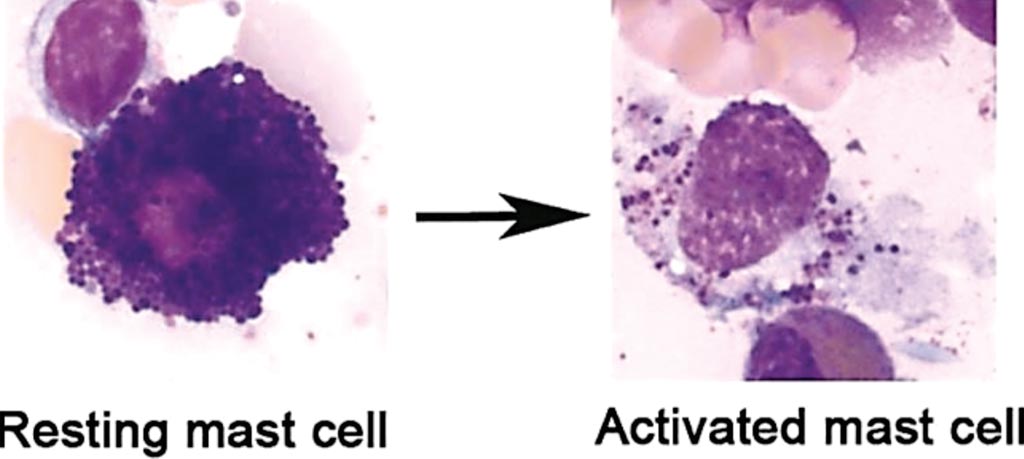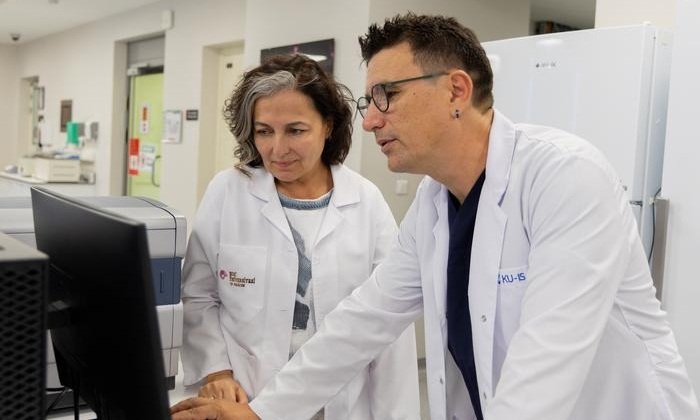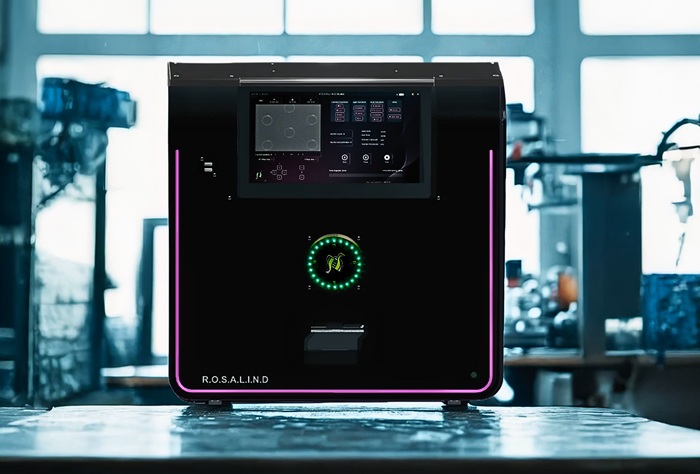Mast Cell Activation Test Diagnoses Allergic Diseases
|
By LabMedica International staff writers Posted on 16 May 2018 |

Image: Mast cells obtained from the human bone marrow; May-Grünwald/Giemsa stain of a resting human mast cell and a mast cell following activation-induced degranulation. Note the loss of granule staining (Photo courtesy of University Hospital of Bonn).
Peanut allergies are among the most common food allergies in children. Currently, doctors diagnose peanut allergy using a skin-prick test or immunoglobulin E (IgE) test, but this may result in over-diagnosis or false-positives and it cannot differentiate between sensitivity and true food allergy.
When skin-prick and IgE test results are unclear, allergists rely on an oral food challenge (OFC), which consists of feeding peanut in incrementally larger doses to a patient in a highly controlled setting in hospital to confirm allergy to the food. While the test is the gold standard for diagnosing food allergies, there is risk of causing severe allergic reactions.
Scientists at the University of Manchester (Manchester, UK) and their colleagues have developed a new laboratory test to diagnose peanut allergy. The team used blood samples from 174 children participating in allergy testing, 73 peanut allergic and 101 peanut-tolerant, the scientists added peanut protein to mast cells to screen for IgE-mediated activation. Levels of total IgE, peanut-specific IgE, and IgE to the recombinant allergen components were measured by using ImmunoCAP. Skin prick tests (SPTs) were undertaken according to national guidelines by using lancets and commercial peanut extract, with 1% histamine as a positive control. Images of mast cell activation were collected on an Olympus BX51 upright microscope.
The scientists found that human blood-derived mast cells (MCs) sensitized with sera from patients with peanut, grass pollen, and Hymenoptera (wasp venom) allergy demonstrated allergen-specific and dose-dependent degranulation, as determined based on both expression of surface activation markers (CD63 and CD107a) and functional assays (prostaglandin D2 and β-hexosaminidase release). In this cohort of peanut-sensitized subjects, the mast cell activation test (MAT) was found to have superior discrimination performance compared with other testing modalities, including component-resolved diagnostics and basophil activation tests. They identified five clusters or patterns of reactivity in the resulting dose-response curves, which at preliminary analysis corresponded to the reaction phenotypes seen at challenge.
The authors concluded that the MAT is a robust tool that can confer superior diagnostic performance compared with existing allergy diagnostics and might be useful to explore differences in effector cell function between basophils and MCs during allergic reactions. The study was published on March 5, 2018, in The Journal of Allergy and Clinical Immunology.
Related Links:
University of Manchester
When skin-prick and IgE test results are unclear, allergists rely on an oral food challenge (OFC), which consists of feeding peanut in incrementally larger doses to a patient in a highly controlled setting in hospital to confirm allergy to the food. While the test is the gold standard for diagnosing food allergies, there is risk of causing severe allergic reactions.
Scientists at the University of Manchester (Manchester, UK) and their colleagues have developed a new laboratory test to diagnose peanut allergy. The team used blood samples from 174 children participating in allergy testing, 73 peanut allergic and 101 peanut-tolerant, the scientists added peanut protein to mast cells to screen for IgE-mediated activation. Levels of total IgE, peanut-specific IgE, and IgE to the recombinant allergen components were measured by using ImmunoCAP. Skin prick tests (SPTs) were undertaken according to national guidelines by using lancets and commercial peanut extract, with 1% histamine as a positive control. Images of mast cell activation were collected on an Olympus BX51 upright microscope.
The scientists found that human blood-derived mast cells (MCs) sensitized with sera from patients with peanut, grass pollen, and Hymenoptera (wasp venom) allergy demonstrated allergen-specific and dose-dependent degranulation, as determined based on both expression of surface activation markers (CD63 and CD107a) and functional assays (prostaglandin D2 and β-hexosaminidase release). In this cohort of peanut-sensitized subjects, the mast cell activation test (MAT) was found to have superior discrimination performance compared with other testing modalities, including component-resolved diagnostics and basophil activation tests. They identified five clusters or patterns of reactivity in the resulting dose-response curves, which at preliminary analysis corresponded to the reaction phenotypes seen at challenge.
The authors concluded that the MAT is a robust tool that can confer superior diagnostic performance compared with existing allergy diagnostics and might be useful to explore differences in effector cell function between basophils and MCs during allergic reactions. The study was published on March 5, 2018, in The Journal of Allergy and Clinical Immunology.
Related Links:
University of Manchester
Latest Immunology News
- Ultrasensitive Liquid Biopsy Demonstrates Efficacy in Predicting Immunotherapy Response
- Blood Test Could Identify Colon Cancer Patients to Benefit from NSAIDs
- Blood Test Could Detect Adverse Immunotherapy Effects
- Routine Blood Test Can Predict Who Benefits Most from CAR T-Cell Therapy
- New Test Distinguishes Vaccine-Induced False Positives from Active HIV Infection
- Gene Signature Test Predicts Response to Key Breast Cancer Treatment
- Chip Captures Cancer Cells from Blood to Help Select Right Breast Cancer Treatment
- Blood-Based Liquid Biopsy Model Analyzes Immunotherapy Effectiveness
- Signature Genes Predict T-Cell Expansion in Cancer Immunotherapy
- Molecular Microscope Diagnostic System Assesses Lung Transplant Rejection
- Blood Test Tracks Treatment Resistance in High-Grade Serous Ovarian Cancer
- Luminescent Probe Measures Immune Cell Activity in Real Time
- Blood-Based Immune Cell Signatures Could Guide Treatment Decisions for Critically Ill Patients
- Novel Tool Predicts Most Effective Multiple Sclerosis Medication for Patients
- Companion Diagnostic Test for CRC Patients Identifies Eligible Treatment Population
- Novel Tool Uses Deep Learning for Precision Cancer Therapy
Channels
Clinical Chemistry
view channel
Noninvasive Blood-Glucose Monitoring to Replace Finger Pricks for Diabetics
People with diabetes often need to measure their blood glucose multiple times a day, most commonly through finger-prick blood tests or implanted sensors. These methods can be painful, inconvenient, and... Read more
POC Breath Diagnostic System to Detect Pneumonia-Causing Pathogens
Pseudomonas aeruginosa is a major cause of hospital-acquired and ventilator-associated pneumonia, particularly in lung transplant recipients and patients with structural lung disease. Its ability to form... Read moreMolecular Diagnostics
view channel
Endometriosis Blood Test Could Replace Invasive Laparoscopic Diagnosis
Endometriosis affects an estimated 1 in 10 women globally, yet diagnosis can take 7 to 10 years on average due to the invasive nature of laparoscopy and lack of accurate, non-invasive tests.... Read more
World's First NGS-Based Diagnostic Platform Fully Automates Sample-To-Result Process Within Single Device
Rapid point-of-need diagnostics are of critical need, especially in the areas of infectious disease and cancer testing and monitoring. Now, a direct-from-specimen platform that performs genomic analysis... Read more
Rapid Diagnostic Breakthrough Simultaneously Detects Resistance and Virulence in Klebsiella Pneumoniae
Antibiotic resistance is a steadily escalating threat to global healthcare, making common infections harder to treat and increasing the risk of severe complications. One of the most concerning pathogens... Read moreHematology
view channel
MRD Tests Could Predict Survival in Leukemia Patients
Acute myeloid leukemia is an aggressive blood cancer that disrupts normal blood cell production and often relapses even after intensive treatment. Clinicians currently lack early, reliable markers to predict... Read more
Platelet Activity Blood Test in Middle Age Could Identify Early Alzheimer’s Risk
Early detection of Alzheimer’s disease remains one of the biggest unmet needs in neurology, particularly because the biological changes underlying the disorder begin decades before memory symptoms appear.... Read more
Microvesicles Measurement Could Detect Vascular Injury in Sickle Cell Disease Patients
Assessing disease severity in sickle cell disease (SCD) remains challenging, especially when trying to predict hemolysis, vascular injury, and risk of complications such as vaso-occlusive crises.... Read more
ADLM’s New Coagulation Testing Guidance to Improve Care for Patients on Blood Thinners
Direct oral anticoagulants (DOACs) are one of the most common types of blood thinners. Patients take them to prevent a host of complications that could arise from blood clotting, including stroke, deep... Read moreMicrobiology
view channel
New UTI Diagnosis Method Delivers Antibiotic Resistance Results 24 Hours Earlier
Urinary tract infections affect around 152 million people every year, making them one of the most common bacterial infections worldwide. In routine medical practice, diagnosis often relies on rapid urine... Read more
Breakthroughs in Microbial Analysis to Enhance Disease Prediction
Microorganisms shape human health, ecosystems, and the planet’s climate, yet identifying them and understanding how they are related remains a major scientific challenge. Even with modern DNA sequencing,... Read morePathology
view channel
AI Tool Simultaneously Identifies Genetic Mutations and Disease Type
Interpreting genetic test results remains a major challenge in modern medicine, particularly for rare and complex diseases. While existing tools can indicate whether a genetic mutation is harmful, they... Read more
Rapid Low-Cost Tests Can Prevent Child Deaths from Contaminated Medicinal Syrups
Medicinal syrups contaminated with toxic chemicals have caused the deaths of hundreds of children worldwide, exposing a critical gap in how these products are tested before reaching patients.... Read more
Tumor Signals in Saliva and Blood Enable Non-Invasive Monitoring of Head and Neck Cancer
Head and neck cancers are among the most aggressive malignancies worldwide, with nearly 900,000 new cases diagnosed each year. Monitoring these cancers for recurrence or relapse typically relies on tissue... Read moreTechnology
view channel
AI Predicts Colorectal Cancer Survival Using Clinical and Molecular Features
Colorectal cancer is one of the most common and deadly cancers worldwide, and accurately predicting patient survival remains a major clinical challenge. Traditional prognostic tools often rely on either... Read more
Diagnostic Chip Monitors Chemotherapy Effectiveness for Brain Cancer
Glioblastoma is one of the most aggressive and fatal brain cancers, with most patients surviving less than two years after diagnosis. Treatment is particularly challenging because the tumor infiltrates... Read moreIndustry
view channel
BD and Penn Institute Collaborate to Advance Immunotherapy through Flow Cytometry
BD (Becton, Dickinson and Company, Franklin Lakes, NJ, USA) has entered into a strategic collaboration with the Institute for Immunology and Immune Health (I3H, Philadelphia, PA, USA) at the University... Read more




















